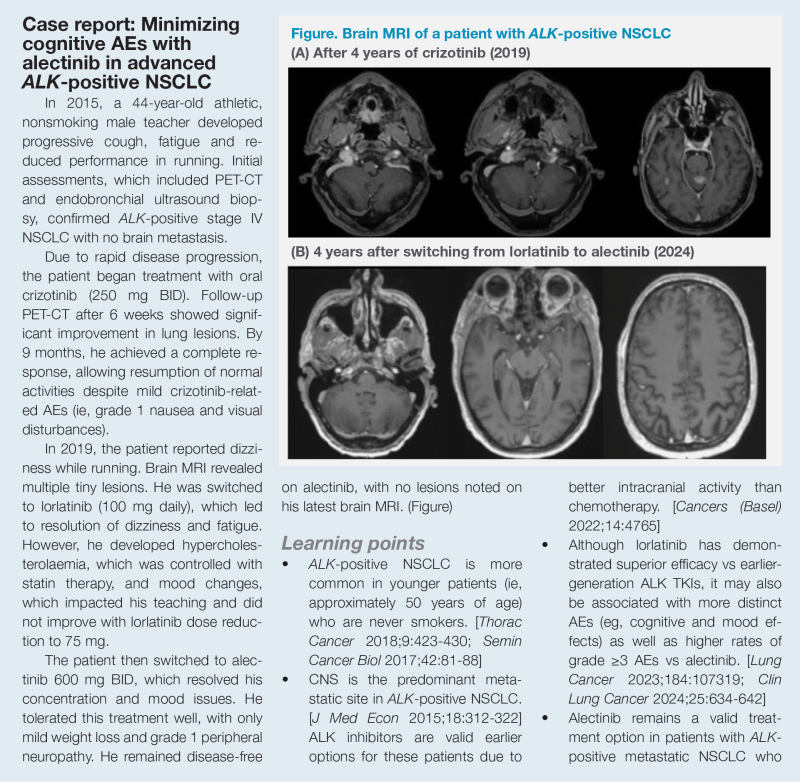Evolving role of alectinib in ALK-positive NSCLC





The prognosis of patients with non-small-cell lung cancer (NSCLC) has markedly improved since the identification of oncogenic driver mutations and concomitant discovery of tyrosine-kinase inhibitors (TKIs). At an industry-sponsored meeting during the Immuno-Oncology Hong Kong (IOHK) 2024 conference, Professor Solange Peters of the University of Lausanne in Switzerland shared her insights and experiences in the management of patients with ALK-positive NSCLC and highlighted the importance of considering toxicity profiles when choosing between ALK TKIs.
ALK inhibitors for NSCLC
Discovery of ALK-positive NSCLC led to rapid characterization of its pathophysiology and the development of ALK TKIs. [Semin Cancer Biol 2017;42:81-88]
Following the significant improvement in progression-free survival (PFS) of almost 4 months demonstrated with the first-generation ALK inhibitor, crizotinib, vs chemotherapy in patients with advanced ALK-positive NSCLC, second- and third-generation ALK TKIs have emerged and are now considered as standard treatments for ALK-positive NSCLC. [N Engl J Med 2014;371:2167-2177; Cancers (Basel) 2022;14:4765] In particular, newer ALK inhibitors demonstrated improved potency, better blood-brain barrier penetration for enhanced central nervous system (CNS) activity, and broader coverage of ALK resistance mutations. [Transl Oncol 2021;14:101191; Cancers (Basel) 2022;14:4765]
Alectinib in ALK-positive NSCLC
The phase III ALEX trial was a key study comparing the second-generation ALK inhibitor alectinib (600 mg BID) vs crizotinib (250 mg BID) in 303 previously untreated patients with advanced ALK-positive NSCLC. [N Engl J Med 2017;377:829-838]
Mature PFS data showed significant improvement with alectinib vs crizotinib (median PFS, 34.8 vs 10.9 months; hazard ratio [HR], 0.43; 95 percent confidence interval [CI], 0.32–0.58). The 5-year overall survival (OS) rates were 62.5 vs 45.5 percent, while median OS was not yet reached for alectinib vs 57.4 months with crizotinib. [Ann Oncol 2020;31:1056-1064] Grade 3–5 adverse events (AEs) were less frequent with alectinib vs crizotinib (41 vs 50 percent). [N Engl J Med 2017;377:829-838]
“These survival results favouring alectinib have also been replicated in clinical trials focusing on Asian patients, including the J-ALEX and ALESIA trials,” shared Peters. [Lung Cancer 2020;139:195-199; Lancet Respir Med 2019;7:437-446; Zhou C, et al, ESMO Asia 2022, abstract LBA11]
These results have led to the approval of alectinib for treatment of adult patients with ALK-positive metastatic NSCLC. [Alecensa Hong Kong Prescribing Information]
“In the first line, several ALK inhibitors may be used for metastatic ALK-positive NSCLC,” noted Peters. [Ann Oncol 2023;34:339-357] Optimal sequencing of ALK TKIs is a crucial consideration, especially in terms of mitigating resistance development. For instance, while lorlatinib use in the first-line setting suppresses a broad spectrum of ALK mutations, it can lead to aberrations in bypass signalling pathways. [J Clin Oncol 2024;42:3400-3409] Its second-line use may lead to development of compound mutations, which are often resistant to available TKIs. [J Clin Oncol 2019;37:1370-1379; Nat Cancer 2022;3:710-722]
“There are currently no approved ALK TKIs after progression on first-line lorlatinib,” Peters remarked. [Ann Oncol 2023;34:339-357] “However, preliminary results from clinical trials investigating fourth-generation ALK TKIs against compound mutations, such as the phase I/II ALKOVE-1 study, are promising.” [Ann Oncol 2024;35(Suppl 2):S802-S803]
Safety of alectinib vs other ALK inhibitors
“Each ALK TKI has a distinct toxicity profile that must be considered in the context of patients’ preferences and lifestyles [see case report],” Peters opined. “In my clinical practice, we hardly use ceritinib due to its reported fatal AEs. We need to recognize the safety profiles of other options after crizotinib and educate patients about potential AEs.” (Table) [J Adv Pract Oncol 2015;6:156-160; Ann Oncol 2023;34:339-357; Lung Cancer 2023;184:107319]

Although there are limited head-to-head studies comparing ALK TKIs, a systematic review and network meta-analysis quantified the toxicity profiles of different ALK TKIs to guide clinical decision-making. Results showed that alectinib had the lowest rates of grade ≥3 AEs among ALK TKIs analyzed, at 16.2 percent, vs 46.4 percent for crizotinib, 63.7 percent for brigatinib and 91.6 percent for lorlatinib. In particular, all-grade lorlatinib-specific AEs that occurred within the first 2 months of its administration included cognitive impact (21 percent) and mood impact (16 percent), which are important concerns for some patients. (Case report) [Lung Cancer 2023;184:107319; Clin Lung Cancer 2024;25:634-642]
Summary
In patients with ALK-positive metastatic NSCLC, selecting an appropriate ALK inhibitor is crucial, as safety and toxicity profiles impact outcomes. Alectinib is recognized for its favourable safety profile, making it a valid option when tolerability issues are anticipated or experienced by patients with other ALK inhibitors. [Lung Cancer 2023;184:107319]
Additionally, alectinib’s role has expanded to include early-stage lung cancer treatment following its approval as adjuvant therapy for patients with resected ALK-positive NSCLC. [Alecensa Hong Kong Prescribing Information; N Engl J Med 2024;390:1265-1276]
